If you’ve ever opened the fridge and smiled at a ready-to-eat jar of oats, you already know the magic of overnight oats. But if you’re managing diabetes, you might wonder—are oats even okay? This article will show how overnight oats for diabetics can be both comforting and blood sugar–friendly. You’ll learn the ideal ingredients, how to naturally sweeten them, smart timing tips, and a delicious base recipe to make your mornings easier. Let’s dig in, one creamy spoonful at a time.
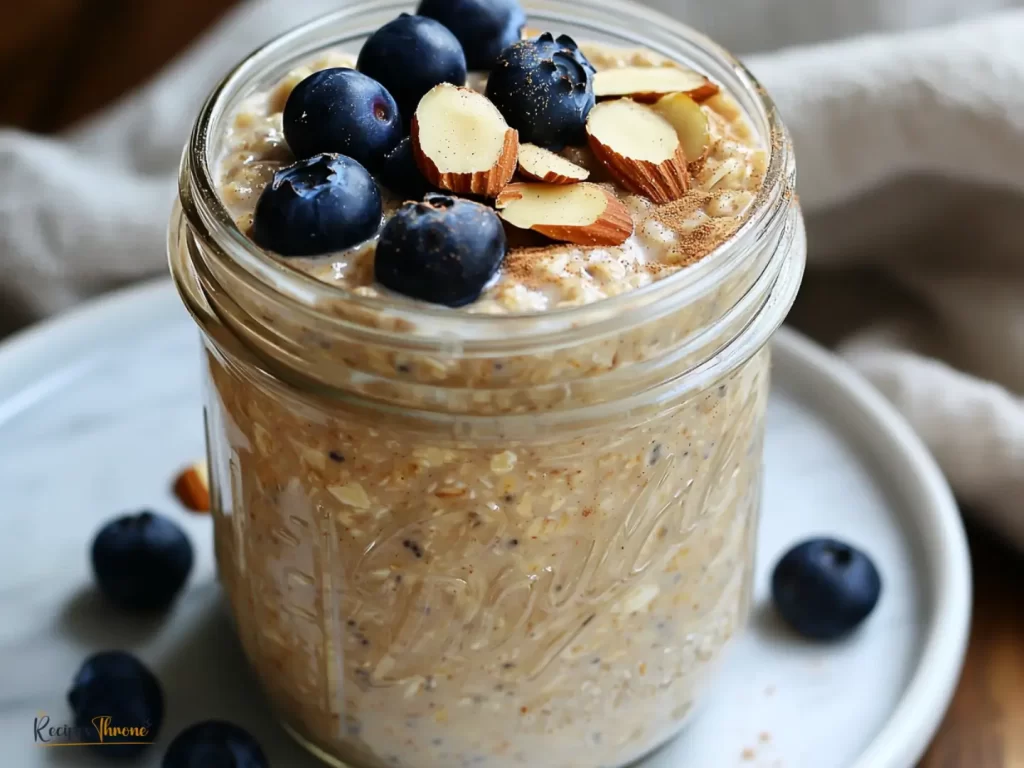
Table of Contents
Why I Started Making Overnight Oats for Diabetics
Back in my early thirties, I watched my dad wrestle with a type 2 diabetes diagnosis. Breakfast became a battleground. Everything he used to love—biscuits, pancakes, sugary cereals—was now a “no.” I remember thinking, there’s got to be a way to make breakfast feel good again. That’s when I stumbled across overnight oats.
I was skeptical. Oats? For a diabetic? But it was like a lightbulb went off once I learned how to use the right kind—like steel-cut or rolled oats—and balance them with protein, fiber, and healthy fats. Suddenly, we had something easy to prep, comforting to eat, and gentle on blood sugar. And yes, it passed my dad’s taste test, too.
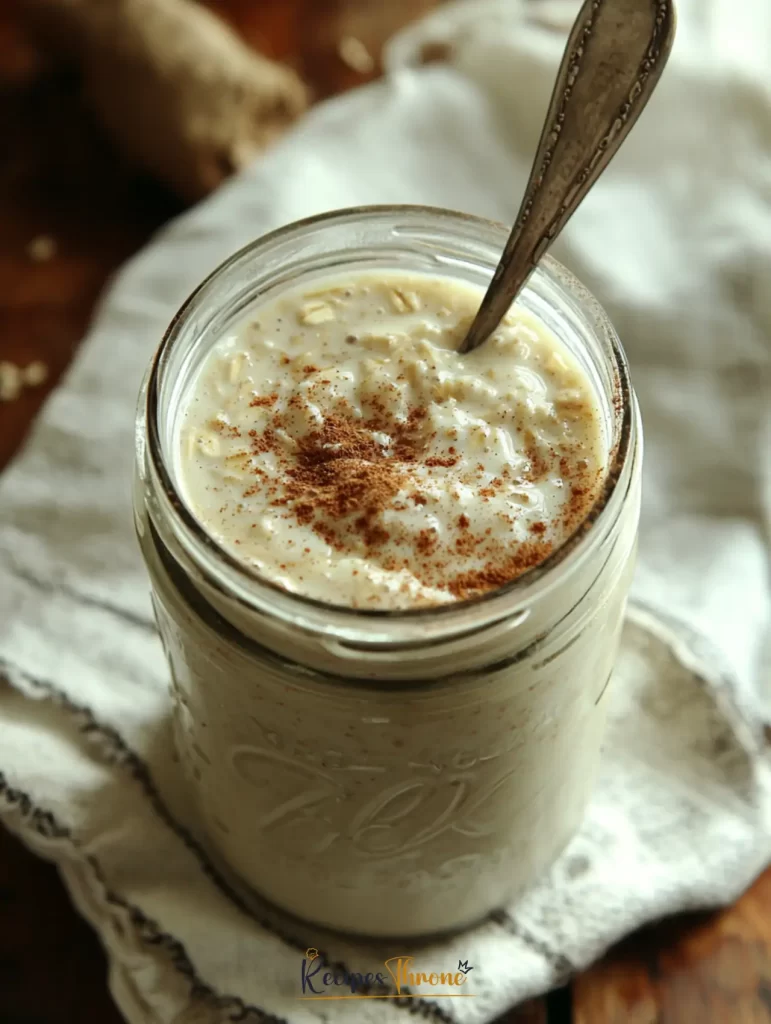
According to Harvard Health, oats’ low glycemic index helps manage blood sugar more effectively.
How Overnight Oats Help Balance Blood Sugar
Oats might be a carb, but they’re a smart carb. They have a low glycemic index, so they raise blood sugar slowly instead of spiking it. That’s a win for anyone managing diabetes. Combined with chia seeds, unsweetened almond milk, and Greek yogurt, they become a powerhouse meal, rich in soluble fiber, protein, and healthy fats.
For more diabetes-friendly comfort meals like this, check out our Easy Slow Cooker Arroz con Pollo (Diabetes-Friendly) or our roundup of Chicken Slow Cooker Mushroom Soup.
Add a sprinkle of cinnamon, a few berries, or even flaxseeds, and you have a recipe supporting glucose control and keeping you fuller longer. According to research, oats may even help reduce inflammation and support heart health—a major bonus for those managing type 2 diabetes or insulin resistance.
Overnight Oats for Diabetics Recipe
Right Ingredients: What to Include & Avoid
When making overnight oats for diabetics, the first step is choosing the right oats. Skip instant oats—they digest quickly and may spike blood sugar. Instead, opt for old-fashioned rolled oats or steel-cut oats. They have a lower glycemic index and offer long-lasting energy.
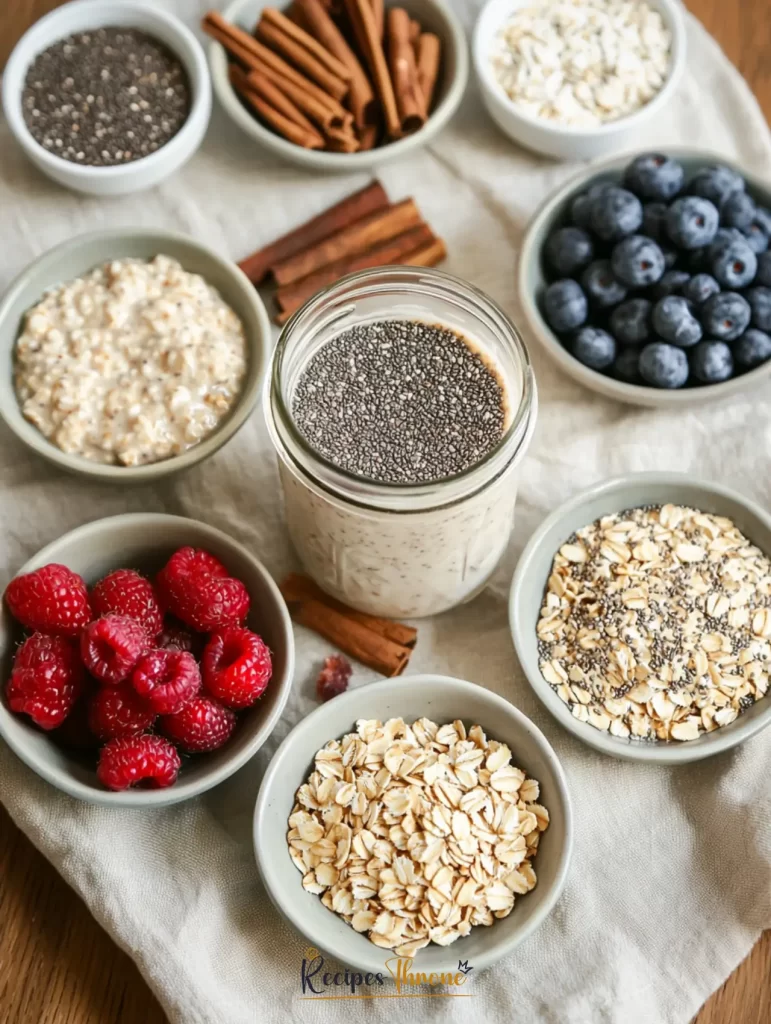
The American Diabetes Association recommends fiber-rich oats and protein for better blood sugar control.
Next, let’s talk milk. Regular dairy milk is higher in natural sugars, so go for unsweetened plant-based options. Almond, soy, and coconut milk are all low in carbs and ideal for keeping your oats diabetes-friendly. Add in chia seeds or flaxseeds—they thicken your oats while adding a fiber and omega-3 boost.
Overnight Oats for Diabetics: Blood Sugar–Friendly Breakfast
- Total Time: 5 minutes + overnight chill
- Yield: 1 serving 1x
- Diet: Diabetic
Description
A creamy, customizable, and blood sugar–friendly breakfast made with low-glycemic oats, protein-rich add-ins, and naturally sweet flavors perfect for diabetic diets.
Ingredients
1/2 cup rolled oats
2/3 cup unsweetened almond milk
1 tbsp chia seeds
1/4 cup plain Greek yogurt
1 tsp stevia or monk fruit sweetener
1/4 tsp ground cinnamon
Optional: 1/4 cup blueberries or raspberries
Instructions
1. Combine oats, chia seeds, and cinnamon in a jar or airtight container.
2. Stir in almond milk, Greek yogurt, and sweetener.
3. Mix thoroughly and seal the container.
4. Refrigerate overnight or for at least 4 hours.
5. In the morning, stir and top with berries or nuts if desired.
6. Enjoy cold, or warm gently before serving.
Notes
Overnight oats can be refrigerated for up to 5 days.
For extra protein, add a scoop of your favorite low-carb protein powder.
To adjust consistency, add more or less almond milk before eating.
- Prep Time: 5 minutes
- Cook Time: 0 minutes
- Category: Breakfast
- Method: No-cook
- Cuisine: American
Nutrition
- Serving Size: 1 jar (approx. 250g)
- Calories: 270
- Sugar: 4g
- Sodium: 90mg
- Fat: 10g
- Saturated Fat: 2g
- Unsaturated Fat: 7g
- Trans Fat: 0g
- Carbohydrates: 30g
- Fiber: 8g
- Protein: 13g
- Cholesterol: 5mg
Need to sweeten things up? Avoid artificial sugars and use natural alternatives like monk fruit, stevia, or cinnamon. A few berries go a long way without sending your blood sugar soaring.
If you’re looking for more creative diabetic meals, don’t miss our Lunch Ideas for Blood Sugar Balance and Low-Carb Smoothie Bowls.
Simple Recipe Template for Overnight Oats for Diabetics
Here’s a base recipe that’s easy to tweak for your taste and carb needs:
| Ingredient | Purpose |
|---|---|
| 1/2 cup rolled oats | Slow-digesting whole grain base |
| 2/3 cup unsweetened almond milk | Low-carb liquid for soaking |
| 1 tbsp chia seeds | Fiber and texture |
| 1 tsp stevia or monk fruit | Blood sugar–safe sweetness |
| 1/4 cup Greek yogurt (optional) | Extra protein & creaminess |
Mix everything in a jar, refrigerate overnight, and you’re done. Top with a few blueberries or almonds in the morning for crunch and antioxidants.
Explore more ingredients like this in our Diabetes-Friendly Pantry Staples or check out High-Fiber Recipes for inspiration.
Sweetening Your Oats Naturally
You don’t have to give up sweetness to enjoy overnight oats with diabetes. Instead, reach for smart alternatives. Monk fruit sweetener and stevia are natural, carb-free choices that won’t cause blood sugar spikes.
Prefer something more natural? Try date paste or mashed banana in small amounts. Even a few berries—like blueberries or raspberries—can offer sweetness and antioxidants without tipping your glucose levels.
Here’s a quick look at sweetener options and their carb impact:
| Sweetener | Approx. Carbs per Serving |
|---|---|
| 1 tbsp maple syrup | 14g |
| 1 tsp stevia | <1g |
| 2 tsp monk fruit | <1g |
| 1/2 mashed banana | 12g |
The key is to sweeten mindfully. With the right balance of ingredients, overnight oats can feel indulgent without sending your glucose on a rollercoaster.
Smart Timing & Meal Planning Tips for overnight oats for diabetics Success
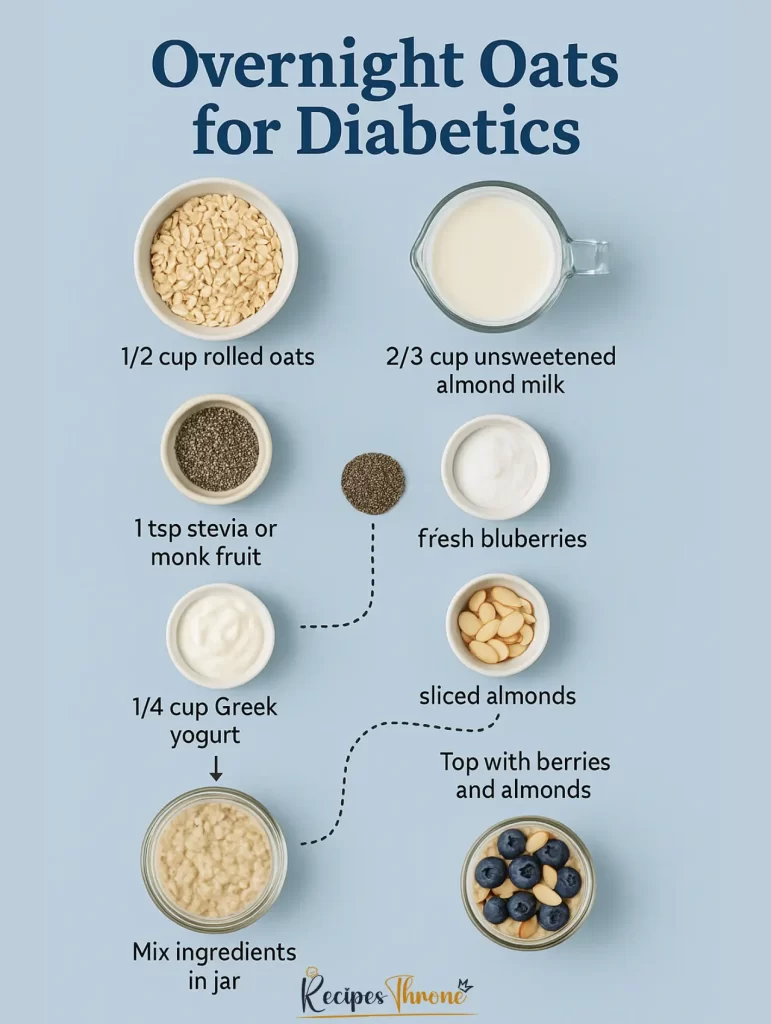
Best Time to Eat Overnight Oats for Blood Sugar Control
Many people assume breakfast is the best time for oats, but if you’re managing diabetes, timing matters. For some, especially those with gestational diabetes, eating carbs in the morning can cause higher glucose spikes due to natural hormonal shifts.
If that’s your case, try enjoying overnight oats for lunch or a midday snack instead. The fiber and protein in oats will still give you steady energy, but with less glycemic impact than a high-carb breakfast.
Want oats in the morning anyway? You can still make it work. Pair your overnight oats with protein-rich options like boiled eggs, a dollop of cottage cheese, or even a low-carb smoothie. The added protein helps slow digestion and keeps blood sugar stable.
For other blood sugar–smart breakfast swaps, check out our High-Protein Breakfasts or Balanced Smoothie Recipes.
Make-Ahead Tips and Storage for Busy Mornings
One reason I love overnight oats so much is that they’re the easiest meal prep win. You can batch them for the entire week and avoid the morning scramble.
Here’s how:
- Prep 3–5 jars at once using your favorite diabetic-friendly base
- Store sealed in the fridge up to 5 days
- Stir before serving, and add toppings (berries, nuts) just before eating
Want to change things up? Rotate flavors: try cinnamon-apple oats one day, chocolate-chia the next. You can also store the dry ingredients in mason jars, then add milk and fruit the night before. Done in 30 seconds flat.
Consistency is key for managing blood sugar. A ready-to-go, portion-controlled option like this can help you stay on track, without sacrificing taste or variety.
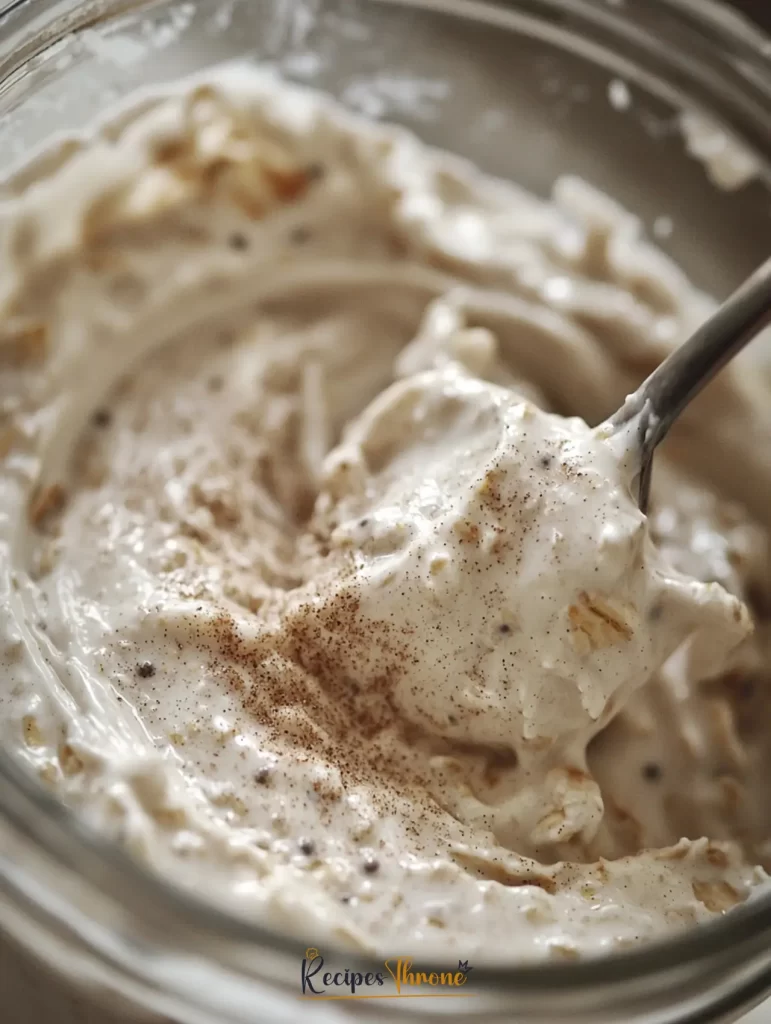
As noted by the Cleveland Clinic, oatmeal with healthy toppings is a top breakfast for diabetics.
Frequently Asked Questions
1- Are overnight oats suitable for diabetics?
Yes, overnight oats can be excellent for diabetics when prepared correctly. Low-glycemic oats, such as steel-cut or rolled oats, combined with fiber-rich ingredients and healthy fats, help prevent blood sugar spikes. Avoid added sugars and opt for natural, low-carb sweeteners like stevia or monk fruit for the best results.
2- What is the healthiest breakfast for a diabetic?
The healthiest breakfast for a diabetic includes fiber, protein, and healthy fats with minimal refined carbs. Options like overnight oats made with almond milk, chia seeds, Greek yogurt, and berries offer a satisfying and blood sugar–free start to the day.
3- How to sweeten overnight oats for diabetics?
The best way to sweeten diabetic overnight oats is by using low-glycemic natural alternatives such as stevia, monk fruit sweetener, or a small amount of mashed banana or berries. You can also add cinnamon for natural sweetness without impacting blood sugar.
Which type of oats is best for diabetics?
Steel-cut oats and old-fashioned rolled oats are best for diabetics because they have a lower glycemic index than instant oats. These varieties digest more slowly, offering steady energy and better blood sugar control.
